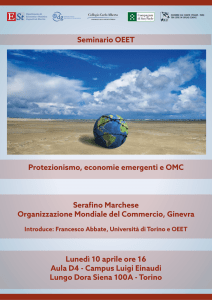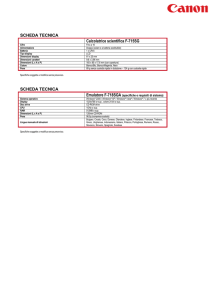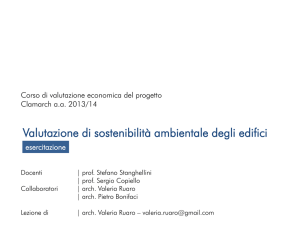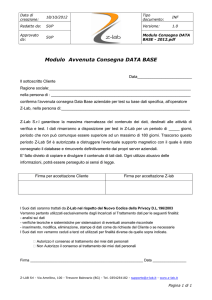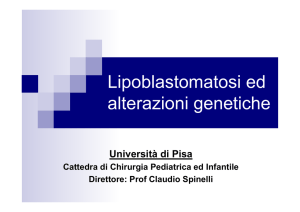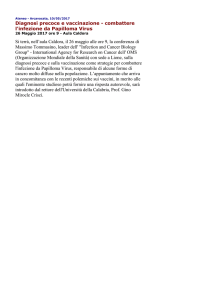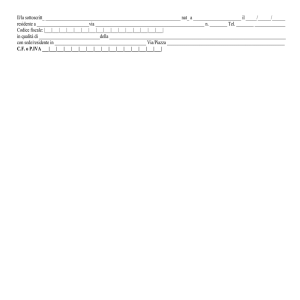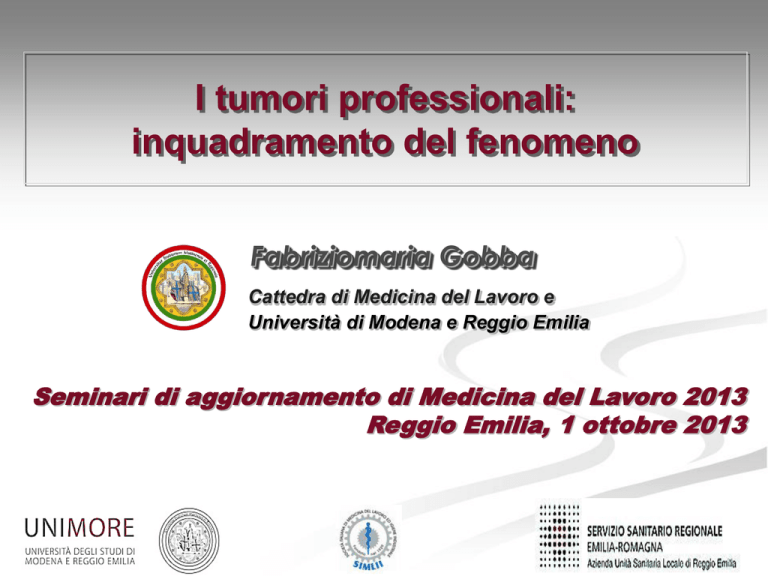
I tumori professionali:
inquadramento del fenomeno
Fabriziomaria Gobba
Cattedra di Medicina del Lavoro e
Università di Modena e Reggio Emilia
Seminari di aggiornamento di Medicina del Lavoro 2013
Reggio Emilia, 1 ottobre 2013
TUMORI PROFESSIONALI:
• Sono i tumori “nella cui genesi ha agito,
come causa o concausa, l’attività lavorativa,
con esposizione ad agenti cancerogeni.”
(A. Forni, I tumori professionali.
In: Foà, Ambrosi. Medicina del Lavoro, Torino, UTET, 2003)
LA RELAZIONE TRA (ALCUNE) ATTIVITA’
LAVORATIVE E TUMORI E’ UN’ACQUISIZIONE
RECENTE?
1775 Percival Pott segnala che nell’anamnesi
lavorativa dei suoi Pz con carcinoma dello
scroto ricorreva spesso il mestiere di
spazzacamino
1873 Richard Wolkmann segnala un alta
incidenza di tumori cutanei (mani, braccia) in
addetti alla lavorazione del catrame
LA RELAZIONE TRA (ALCUNE) ATTIVITA’
LAVORATIVE E TUMORI E’ UN’ACQUISIZIONE
RECENTE?
1775 Percival Pott segnala che nell’anamnesi
dei suoi Pz con carcinoma dello scroto
ricorreva spesso il mestiere di spazzacamino
1873 Richard Wolkmann segnala un alta
incidenza di tumori cutanei (mani, braccia) in
addetti alla lavorazione del catrame
1915 Yamagiwa e Ichikava riescono a indurre
sperimentalmente il cancro da catrame
mediante spennellamento sulla cute
dell’orecchio del coniglio
1932 Cook e Kennaway identificano la
sostanza responsabile: il 3-4 benzopirene
1775 - 1932 = oltre 150 anni
LE CONOSCENZE ATTUALI:
QUALI SOSTANZE/AGENTI/ESPOSIZIONI
SONO CANCEROGENE?
The IARC Monographs, International Agency for Research on Cancer (IARC)
(http://monographs.iarc.fr/)
American Conference of Governmental Industrial Hygienists (ACGIH)
http://www.cdc.gov/niosh/topics/cancer/npotocca.html
Carcinogens, American Cancer Society (ACS)
http://www.cancer.org/Cancer/CancerCauses/OtherCarcinogens/index
Understanding Cancer Series, National Cancer Institute (NCI)
http://www.cancer.gov/cancertopics/understandingcancer/environment
Chemicals of Public Health Concern, World Health Organization (WHO)
http://www.who.int/ipcs/assessment/public_health/chemicals_phc/en/index.html
Report on Carcinogens, National Toxicology Program (NTP)
http://ntp.niehs.nih.gov/?objectid=72016262Science and Technology: Health, Environmental Protection Agency (EPA)
http://www.epa.gov/gateway/science/humanhealth.html
Work-Related Lung Disease (WoRLD) Surveillance System, National Institute
for Occupational Safety and Health (NIOSH)
http://www2.cdc.gov/drds/WorldReportData/
Altri Comm Cons Toss Naz (CCTN), ATSDR, IPCS-INCHEM, ecc
Agents Classified by the IARC Monographs,
Volumes 1 -102
Group 1
Carcinogenic to humans
107 agents
Group 2A Probably carcinogenic to humans
59
Group 2B Possibly carcinogenic to humans
267
Group 3
Not classif. as to its carcinogenicity to humans
508
Group 4
Probably not carcinogenic to humans
1
Agents Classified by the IARC Monographs,
Volumes 1 -106
Group 1
Carcinogenic to humans
109 agents
Group 2A Probably carcinogenic to humans
65
Group 2B Possibly carcinogenic to humans
275
Group 3
Not classif. as to its carcinogenicity to humans
503
Group 4
Probably not carcinogenic to humans
1
Agents Classified by the IARC Monographs, Volumes 1–106
CAS No
Agent
Group
Volume
Year
000075-07-0 Acetaldehyde associated with consumption of alcoholic
beverages
Acid mists, strong inorganic
001402-68-2 Aflatoxins
Alcoholic beverages
Aluminium production
1
100E
2012
1
1
1
1
2012
2012
2012
2012
000092-67-1 4-Aminobiphenyl
1
Areca nut
000313-67-7 Aristolochic acid
(NB: Overall evaluation upgraded to Group 1 based on
mechanistic and other relevant data)
000313-67-7 Aristolochic acid, plants containing
007440-38-2 Arsenic and inorganic arsenic compounds
1
1
54, 100F
56, 82, 100F
44, 96, 100E
34, Sup 7,
100F
1, Sup 7, 99,
100F
85, 100E
82, 100A
82, 100A
23, Sup 7,
100C
14, Sup 7,
100C
2012
2012
001332-21-4 Asbestos (all forms, including actinolite, amosite,
013768-00-8 anthophyllite, chrysotile, crocidolite, tremolite)
(NB: Mineral substances (e.g. talc or vermiculite) that
012172-73-5
contain asbestos should also be regarded as
017068-78-9 carcinogenic to humans.)
012001-29-5
012001-28-4
014567-73-8
1
1
1
2012
2012
2012
2012
012172-73-5
017068-78-9
012001-29-5
012001-28-4
014567-73-8
(NB: Mineral substances (e.g. talc or vermiculite) that
contain asbestos should also be regarded as
carcinogenic to humans.)
Auramine production
1
000446-86-6 Azathioprine
1
000071-43-2 Benzene
1
000092-87-5 Benzidine
1
Benzidine, dyes metabolized to
(NB: Overall evaluation upgraded to Group 1 based on
mechanistic and other relevant data)
000050-32-8 Benzo[a]pyrene
(NB: Overall evaluation upgraded to Group 1 based on
mechanistic and other relevant data)
007440-41-7 Beryllium and beryllium compounds
Betel quid with tobacco
Betel quid without tobacco
1
Sup 7, 99,
100F
26, Sup 7,
100A
29, Sup 7.
100F
29, Sup 7,
99, 100F
99, 100F
1
92, 100F
2012
1
1
1
58, 100C
85, 100E
85, 100E
2012
2012
2012
1
2012
2012
2012
2012
2012
CAS No
Agent
Group
Volume
000542-88-1 Bis(chloromethyl)ether; chloromethyl methyl ether
000107-30-2 (technical-grade)
000055-98-1 Busulfan
1
4, Sup 7,
100F
2012
1
2012
000106-99-0 1,3-Butadiene
007440-43-9 Cadmium and cadmium compounds
000305-03-3 Chlorambucil
1
1
1
000494-03-1 Chlornaphazine
1
018540-29-9 Chromium (VI) compounds
Clonorchis sinensis (infection with)
Coal, indoor emissions from household combustion of
Coal gasification
008007-45-2 Coal-tar distillation
065996-93-2 Coal-tar pitch
1
1
1
1
1
1
Coke production
000050-18-0 Cyclophosphamide
006055-19-2
059865-13-3 Cyclosporine
079217-60-0
000056-53-1 Diethylstilbestrol
1
1
4, Sup 7,
100A
97, 100F
58, 100C
26, Sup 7,
100A
4, Sup 7,
100A
49, 100C
61, 100B
95, 100E
92, 100F
92, 100F
35, Sup 7,
100F
92, 100F
26, Sup 7,
100A
Engine exhaust, diesel
Year
2012
2012
2012
2012
2012
2012
2012
2012
2012
2012
2012
2012
1
50, 100A
2012
1
21, Sup 7,
100A
46, 105
2012
1
in prep
100A
006055-19-2
059865-13-3 Cyclosporine
079217-60-0
000056-53-1 Diethylstilbestrol
1
50, 100A
2012
1
2012
Engine exhaust, diesel
Epstein-Barr virus
066733-21-9 Erionite
1
1
1
Estrogen therapy, postmenopausal
Estrogen-progestogen menopausal therapy (combined)
Estrogen-progestogen oral contraceptives (combined)
(NB: There is also convincing evidence in humans that
these agents confer a protective effect against cancer in
the endometrium and ovary)
000064-17-5 Ethanol in alcoholic beverages
000075-21-8 Ethylene oxide
(NB: Overall evaluation upgraded to Group 1 based on
mechanistic and other relevant data)
033419-42-0 Etoposide
(NB: Overall evaluation upgraded to Group 1 based on
mechanistic and other relevant data)
1
1
1
21, Sup 7,
100A
46, 105
70, 100B
42, Sup 7,
100C
72, 100A
72, 91, 100A
72, 91, 100A
1
1
96, 100E
97, 100F
2012
2012
1
76, 100A
2012
2
in prep
2012
2012
2012
2012
2012
CAS No
Agent
033419-42-0 Etoposide in combination with cisplatin and bleomycin
015663-27-1
011056-06-7
Fission products, including strontium-90
000050-00-0 Formaldehyde
Haematite mining (underground)
Helicobacter pylori (infection with)
Hepatitis B virus (chronic infection with)
Hepatitis C virus (chronic infection with)
Human immunodeficiency virus type 1 (infection with)
Human papillomavirus types 16, 18, 31, 33, 35, 39, 45,
51, 52, 56, 58, 59
(NB: The HPV types that have been classified as
carcinogenic to humans can differ by an order of
magnitude in risk for cervical cancer)
Human T-cell lymphotropic virus type I
Ionizing radiation (all types)
Iron and steel founding (occupational exposure during)
Isopropyl alcohol manufacture using strong acids
Kaposi sarcoma herpesvirus
Leather dust
Magenta production
000148-82-3 Melphalan
Group
Volume
Year
1
76, 100A
2012
1
1
1
100D
88, 100F
1, Sup 7,
100D
61, 100B
59, 100B
59, 100B
67, 100B
64, 90, 100B
2012
2012
2012
1
1
1
1
1
1
1
1
1
1
1
1
1
67, 100B
100D
34, Sup 7,
100F
Sup 7, 100F
70, 100B
100C
57, 99, 100F
9, Sup 7,
2012
2012
2012
2012
2012
2012
2012
2012
2012
2012
2012
2012
2012
Iron and steel founding (occupational exposure during)
1
Isopropyl alcohol manufacture using strong acids
Kaposi sarcoma herpesvirus
Leather dust
Magenta production
000148-82-3 Melphalan
1
1
1
1
1
000298-81-7 Methoxsalen (8-methoxypsoralen) plus ultraviolet A
radiation
000101-14-4 4,4'-Methylenebis(2-chloroaniline) (MOCA)
(NB: Overall evaluation upgraded to Group 1 based on
mechanistic and other relevant data)
Mineral oils, untreated or mildly treated
1
MOPP and other combined chemotherapy including
alkylating agents
000091-59-8 2-Naphthylamine
Neutron radiation
(NB: Overall evaluation upgraded to Group 1 wit h
supporting evidence from other relevant data)
Nickel compounds
3
1
1
34, Sup 7,
100F
Sup 7, 100F
70, 100B
100C
57, 99, 100F
9, Sup 7,
100A
24, Sup 7,
100A
57, 99, 100F
2012
2012
2012
2012
2012
2012
2012
2012
33, Sup 7,
100F
Sup 7, 100A
2012
2012
1
4, Sup 7, 99,
100F
75, 100D
1
49, 100C
2012
1
1
2012
2012
Agents Classified by the IARC Monographs, Volumes 1–106
CAS No
Agent
016543-55-8 N'-Nitrosonornicotine (NNN) and 4-(N064091-91-4 Nitrosomethylamino)-1-(3-pyridyl)-1-butanone (NNK)
(NB: Overall evaluation upgraded to Group 1 based on
mechanistic and other relevant data)
Opisthorchis viverrini (infection with)
Painter (occupational exposure as a)
057465-28-8 3,4,5,3’,4’-Pentachlorobiphenyl (PCB-126)
(NB: Overall evaluation upgraded to Group 1 based on
mechanistic and other relevant data)
057117-31-4 2,3,4,7,8-Pentachlorodibenzofuran
(NB: Overall evaluation upgraded to Group 1 based on
mechanistic and other relevant data)
000062-44-2 Phenacetin
(NB: Overall evaluation upgraded to Group 1 wit h
supporting evidence from other relevant data)
Phenacetin, analgesic mixtures containing
014596-37-3 Phosphorus-32, as phosphate
007440-07-5 Plutonium
Radioiodines, including iodine-131
Radionuclides, alpha-particle-emitting, internally
deposited
(NB: Specific radionuclides for which there is sufficient
Group
Volume
Year
1
89, 100E
2012
1
1
1
61, 100B
47, 98, 100F
100F
2012
2012
2012
1
100F
2012
1
24, Sup 7,
100A
2012
1
1
1
1
1
Sup 7, 100A
78, 100D
78, 100D
78, 100D
78, 100D
2012
2012
2012
2012
2012
014596-37-3 Phosphorus-32, as phosphate
007440-07-5 Plutonium
Radioiodines, including iodine-131
Radionuclides, alpha-particle-emitting, internally
deposited
(NB: Specific radionuclides for which there is sufficient
evidence in humans are also listed individually as
Group 1 agents)
Radionuclides, beta-particle-emitting, internally deposited
(NB: Specific radionuclides for which there is sufficient
evidence in humans are also listed individually as
Group 1 agents)
013233-32-4 Radium-224 and its decay products
013982-63-3 Radium-226 and its decay products
015262-20-1 Radium-228 and its decay products
010043-92-2 Radon-222 and its decay products
Rubber manufacturing industry
1
1
1
1
78, 100D
78, 100D
78, 100D
78, 100D
2012
2012
2012
2012
1
78, 100D
2012
1
1
1
1
1
2012
2012
2012
2012
2012
Salted fish, Chinese-style
Schistosoma haematobium (infection with)
013909-09-6 Semustine [1-(2-Chloroethyl)-3-(4-methylcyclohexyl)-1nitrosourea, Methyl-CCNU]
068308-34-9 Shale oils
1
1
1
78, 100D
78, 100D
78, 100D
43, 78, 100D
28, Sup 7,
100F
56, 100E
61, 100B
Sup 7, 100A
014808-60-7 Silica dust, crystalline, in the form of quartz or cri stobalite
Solar radiation
1
1
1
35, Sup 7,
100F
68, 100C
55, 100D
2012
2012
2012
2012
2012
2012
CAS No
Agent
Group
Soot (as found in occupational exposure of chimney
sweeps)
000505-60-2 Sulfur mustard
1
010540-29-1 Tamoxifen
(NB: There is also conclusive evidence that tamoxifen
reduces the risk of contralateral breast cancer in breast
cancer patients)
001746-01-6 2,3,7,8-Tetrachlorodibenzo-para-dioxin
000052-24-4 Thiotepa
007440-29-1 Thorium-232 and its decay products
Tobacco, smokeless
Tobacco smoke, second-hand
Tobacco smoking
000095-53-4 ortho-Toluidine
000299-75-2 Treosulfan
1
000079-01-6 Trichloroethylene
Ultraviolet radiation (wavelengths 100-400 nm,
encompassing UVA, UVB, and UVC)
Ultraviolet-emitting tanning devices
000075-01-4 Vinyl chloride
Wood dust
X- and Gamma-Radiation
000079-06-1 Acrylamide
(NB: Overall evaluation upgraded to Group 2A with
1
1
1
1
1
1
1
1
1
1
1
1
1
1
1
2A
Volume
Year
35, Sup 7,
100F
9, Sup 7,
100F
66, 100A
2012
69, 100F
50, 100A
78, 100D
89, 100E
83, 100E
83, 100E
77, 99, 100F
26, Sup 7,
100A
63, 106
100D
2012
2012
2012
2012
2012
2012
2012
2012
100D
97, 100F
62, 100C
75, 100D
60
2012
2012
in prep
2012
2012
2012
2012
2012
1994
Agente cancerogeno:
(Definizione Formale, D.Lgls 81/2008)
1) una sostanza che risponde ai criteri relativi alla classificazione
quali categorie cancerogene 1 o 2 (R45, R49, o H350, H351),
stabiliti ai sensi del decreto legislativo 3 febbraio 1997, n. 52, e
successive modificazioni;
2) un preparato contenente una o piu' sostanze di cui al numero
1), quando la concentrazione di una o piu' delle singole
sostanze risponde ai requisiti relativi ai limiti di concentrazione
per la classificazione di un preparato nelle categorie
cancerogene 1 o 2 in base ai criteri stabiliti dai decreti
legislativi 3 febbraio 1997, n. 52, e 14 marzo 2003, n. 65 e
successive modificazioni;
3) una sostanza, un preparato o un processo di cui all'allegato
XLII, nonche' una sostanza od un preparato emessi durante un
processo previsto dall'allegato XLII;
D.Lgsl 81/2008, Art. 234.
LE CONOSCENZE ATTUALI:
QUALI LE LOCALIZZAZIONI DEI TUMORI
PROFESSIONALI
List of Classifications by cancer sites with sufficient or limited evidence in
humans, Volumes 1 to 105*
Cancer site
Carcinogenic agents with sufficient
evidence in humans
Agents with limited evidence
in humans
* This table does not include factors not covered in the IARC Monographs, notably genetic traits,
reproductive status, and some nutritional factors.
Adapted from Table 4 in Cogliano et al. (2011) available at:
http://jnci.oxfordjournals.org/content/early/2011/12/11/jnci.djr483.short?rss=1
Last update: 7 November 2012
List of Classifications by cancer sites with sufficient or limited evidence in
humans, Volumes 1 to 105*
Cancer site
Carcinogenic agents with sufficient
evidence in humans
Agents with limited evidence
in humans
Lip, oral Cavity, and pharynx
Lip
Solar radiation
Oral cavity
Alcoholic beverages
Betel quid with tobacco
Betel quid without tobacco
Human papillomavirus type 16
Tobacco, smokeless
Tobacco smoking
Human papillomavirus type 18
Salivary gland
X-radiation, gamma-radiation
Radioiodines, including Iodine131
Tonsil
Human papillomavirus type 16
Pharynx
Alcoholic beverages
Betel quid with tobacco
Human papillomavirus type 16
Tobacco smoking
Nasopharynx
Epstein-Barr virus
Formaldehyde
Salted fish, Chinese-style
Tobacco smoking
Wood dust
Digestive tract, upper
Acetaldehyde associated with
consumption of alcoholic beverages
Asbestos (all forms)
Mate drinking, hot
Printing processes
Tobacco smoke, secondhand
consumption of alcoholic beverages
Digestive organs
Oesophagus
Acetaldehyde associated with
consumption of alcoholic beverages
Alcoholic beverages
Betel quid with tobacco
Betel quid without tobacco
Tobacco, smokeless
Tobacco
smoking sites with sufficient
List of Classifications
by cancer
humans, Volumes 1X-radiation,
to 105* gamma-radiation
Dry cleaning
Mate drinking, hot
Pickled vegetables (traditional
Asian)
Rubber production industry
or limited evidence in
Cancer site
Carcinogenic agents with sufficient
evidence in humans
Agents with limited evidence
in humans
Stomach
Helicobacter pylori
Rubber production industry
Tobacco smoking
X-radiation, gamma-radiation
Asbestos (all forms)
Epstein-Barr virus
Lead compounds, inorganic
Nitrate or nitrite (ingested)
under conditions that result
in endogenous nitrosation
Pickled vegetables (traditional
Asian)
Salted fish, Chinese-style
1
Colon and rectum
Alcoholic beverages
Tobacco smoking
X-radiation, gamma-radiation
Asbestos (all forms)
Schistosoma japonicum
Anus
Human immunodeficiency virus type 1
Human papillomavirus type 16
Human papillomavirus types
18, 33
X-radiation, gamma-radiation
Anus
Liver and bile duct
Human immunodeficiency virus type 1
Human papillomavirus type 16
Aflatoxins
Alcoholic beverages
Clonorchis sinensis
Estrogen-progestogen contraceptives
Hepatitis B virus
Hepatitis C virus
Opisthorchis viverrini
Plutonium
Thorium-232 and its decay products
Tobacco smoking (in smokers and in
smokers’ children)
Vinyl chloride
Gall bladder
Thorium-232 and its decay products
Pancreas
Tobacco, smokeless
Tobacco smoking
Digestive tract,
unspecified
Human papillomavirus types
18, 33
Androgenic (anabolic) steroids
Arsenic and inorganic arsenic
compounds
Betel quid without tobacco
Human immunodeficiency virus
type 1
Polychlorinated biphenyls
Schistosoma japonicum
Trichloroethylene
X-radiation, gamma-radiation
Alcoholic beverages
Thorium-232 and its decay
products
X-radiation, gamma-radiation
Radioiodines, including Iodine131
humans, Volumes 1 to 105*
Carcinogenic agents with sufficient
evidence in humans
Agents with limited evidence
in humans
Nasal cavity and
paranasal sinus
Isopropyl alcohol production
Leather dust
Nickel compounds
Radium-226 and its decay products
Radium-228 and its decay products
Tobacco smoking
Wood dust
Carpentry and joinery
Chromium(VI) compounds
Formaldehyde
Textile manufacturing
Larynx
Acid mists, strong inorganic
Alcoholic beverages
Asbestos (all forms)
Tobacco smoking
Human papillomavirus type 16
Mate drinking, hot
Rubber production industry
Sulfur mustard
Tobacco smoke, secondhand
Cancer site
Respiratory organs
Lung
Aluminum production
Arsenic and inorganic arsenic compounds
Asbestos (all forms)
Beryllium and beryllium compounds
Bis(chloromethyl)ether; chloromethyl
methyl ether (technical grade)
Cadmium and cadmium compounds
Chromium(VI) compounds
Coal, indoor emissions from household
combustion
Coal gasification
Coal-tar pitch
Coke production
Engine exhaust, diesel
Hematite mining (underground)
Iron and steel founding
MOPP (vincristine-prednisone-nitrogen
mustard-procarbazine mixture)
Nickel compounds
Painting
Plutonium
Radon-222 and its decay products
Rubber production industry
Silica dust, crystalline
Soot
Sulfur mustard
Tobacco smoke, secondhand
Tobacco smoking
X-radiation, gamma-radiation
Acid mists, strong inorganic
Art glass, glass containers and
pressed ware (manufacture
of)
Biomass fuel (primarily wood),
indoor emissions from
household combustion of
Bitumens, occupational
exposure to oxidized
bitumens and their
emissions during roofing
Bitumens, occupational
exposure to hard bitumens
and their emissions during
mastic asphalt work
Carbon electrode manufacture
alpha-Chlorinated toluenes and
benzoyl chloride (combined
exposures)
Cobalt metal with tungsten
carbide
Creosotes
Engine exhaust, diesel
Frying, emissions from hightemperature
Insecticides, non-arsenical
(occupational exposures in
spraying and application)
Printing processes
2,3,7,8-Tetrachlorodibenzopara-dioxin
Welding fumes
Welding fumes
Bone, skin, and mesothelium, endothelium, and soft tissue
Bone
Plutonium
Radioiodines, including Iodine131
Radium-224
and its
decay
products
List of Classifications
by cancer
sites
with
sufficient or limited
evidence in
humans, Volumes 1Radium-226
to 105* and its decay products
Radium-228 and its decay products
X-radiation, gamma-radiation
Cancer site
Skin (melanoma)
Carcinogenic agents with sufficient
Solar radiation
evidence
in humans
Agents with limited evidence
in humans
Ultraviolet-emitting tanning devices
Skin (other malignant
neoplasms)
Arsenic and inorganic arsenic compounds
Azathioprine
Coal-tar distillation
4
Coal-tar pitch
Cyclosporine
Methoxsalen plus ultraviolet A
Mineral oils, untreated or mildly treated
Shale oils
Solar radiation
Soot
X-radiation, gamma-radiation
Mesothelium (pleura
and peritoneum)
Asbestos (all forms)
Erionite
Painting
Endothelium (Kaposi
sarcoma)
Human immunodeficiency virus type 1
Kaposi sarcoma herpes virus
Soft tissue
Creosotes
Human immunodeficiency virus
type 1
Human papillomavirus types 5
and 8 (in patients with
epidermodysplasia
verruciformis)
Nitrogen mustard
Petroleum refining
(occupational exposures)
Ultraviolet-emitting tanning
devices
Merkel cell polyomavirus
(MCV)
Polychlorophenols or their
sodium salts (combined
exposures)
Radioiodines, including Iodine131
2,3,7,8-Tetrachlorodibenzopara-dioxin
2,3,7,8-Tetrachlorodibenzopara-dioxin
Breast and female genital organs
Breast
Alcoholic beverages
Diethylstilbestrol
Estrogen-progestogen contraceptives
Estrogen-progestogen menopausal
therapy
X-radiation, gamma-radiation
Estrogen menopausal therapy
Ethylene oxide
Shiftwork that involves
circadian disruption
Tobacco smoking
Vulva
Human
type
16 sufficient or
Human
immunodeficiency
List of Classifications
bypapillomavirus
cancer sites
with
limited
evidence invirus
type 1
humans, Volumes 1 to 105*
Human papillomavirus types
18, 33
Vagina
Diethylstilbestrol (exposure in utero)
evidence in humans
Human papillomavirus type 16
Carcinogenic agents with sufficient
Agents
with limited evidence
Human immunodeficiency virus
in humans
type 1
Uterine cervix
Diethylstilbestrol (exposure in utero)
Estrogen-progestogen contraceptives
Human immunodeficiency virus type 1
5 16, 18, 31,
Human papillomavirus types
33, 35, 39, 45, 51, 52, 56, 58, 59
Tobacco smoking
Human papillomavirus types
26, 53, 66, 67, 68, 70, 73,
82
Endometrium
Estrogen menopausal therapy
Estrogen-progestogen menopausal
therapy
Tamoxifen
Diethylstilbestrol
Ovary
Asbestos (all forms)
Estrogen menopausal therapy
Tobacco smoking
Talc-based body powder
(perineal use)
X-radiation, gamma-radiation
Cancer site
therapy
Tamoxifen
Ovary
Asbestos (all forms)
Estrogen menopausal therapy
Tobacco smoking
Talc-based body powder
(perineal use)
X-radiation, gamma-radiation
Human papillomavirus type 16
Human immunodeficiency virus
type 1
Human papillomavirus type 18
Male genital organs
Penis
Prostate
Androgenic (anabolic) steroids
Arsenic and inorganic arsenic
compounds
Cadmium and cadmium
compounds
Rubber production industry
Thorium-232 and its decay
products
X-radiation, gamma-radiation
Testis
Diethylstilbestrol (exposure in
utero)
Urinary tract
Kidney
Tobacco smoking
X-radiation, gamma-radiation
Trichloroethylene
Arsenic and inorganic arsenic
compounds
Cadmium and cadmium
compounds
Thorium-232 and its decay
products
X-radiation, gamma-radiation
Testis
Diethylstilbestrol (exposure in
utero)
Urinary tract
Kidney
Tobacco smoking
X-radiation, gamma-radiation
Trichloroethylene
Arsenic and inorganic arsenic
compounds
Cadmium and cadmium
compounds
Printing processes
Renal pelvis and
ureter
Aristolochic acid, plants containing
Phenacetin
Phenacetin, analgesic mixtures containing
Tobacco smoking
Aristolochic acid
6
List of Classifications by cancer sites with sufficient or limited evidence in
humans, Volumes 1 to 105*
Cancer site
Carcinogenic agents with sufficient
evidence in humans
Agents with limited evidence
in humans
Urinary bladder
Aluminum production
4-Aminobiphenyl
Arsenic and inorganic arsenic compounds
Auramine production
Benzidine
Chlornaphazine
Cyclophosphamide
Magenta production
2-Naphthylamine
Painting
Rubber production industry
Schistosoma haematobium
Tobacco smoking
ortho-Toluidine
X-radiation, gamma-radiation
4-Chloro-ortho-toluidine
Coal-tar pitch
Coffee
Dry cleaning
Engine exhaust, diesel
Hairdressers and barbers
(occupational exposure)
Printing processes
Soot
Textile manufacturing
Tetrachloroethylene
Eye, brain, and central nervous sy stem
Eye
Human immunodeficiency virus type 1
Ultraviolet-emitting tanning devices
Solar radiation
2-Naphthylamine
Painting
Rubber production industry
Schistosoma haematobium
Tobacco smoking
ortho-Toluidine
X-radiation, gamma-radiation
Textile manufacturing
Tetrachloroethylene
Eye, brain, and central nervous sy stem
Eye
Human immunodeficiency virus type 1
Ultraviolet-emitting tanning devices
Welding
Solar radiation
Brain and central
nervous system
X-radiation, gamma-radiation
Radiofrequency
electromagnetic fields
(including from wireless
phones)
Endocrine glands
Thyroid
Radioiodines, including Iodine-131
X-radiation, gamma-radiation
Lymphoid, hematopoietic, and related tissue
Leukaemia and/or
lymphoma
Azathioprine
Benzene
Busulfan
1,3-Butadiene
Chlorambucil
Cyclophosphamide
Cyclosporine
Epstein-Barr virus
Etoposide with cisplatin and bleomycin
Fission products, including Strontium-90
Formaldehyde
Helicobacter pylori
Hepatitis C virus
Human immunodeficiency virus type 1
Human T-cell lymphotropic virus type 1
Kaposi sarcoma herpes virus
Melphalan
MOPP (vincristine-prednisone-nitrogen
mustard-procarbazine mixture)
Phosphorus-32
Rubber production industry
Semustine (methyl-CCNU)
Thiotepa
Thorium-232 and its decay products
Tobacco smoking
Treosulfan
X-radiation, gamma-radiation
Bischloroethyl nitrosourea
(BCNU)
Chloramphenicol
Ethylene oxide
Etoposide
Hepatitis B virus
Magnetic fields, extremely low
frequency (childhood
leukemia)
Mitoxantrone
Nitrogen mustard
Painting (childhood leukemia
from maternal exposure)
Petroleum refining
(occupational exposures)
Polychlorophenols or their
sodium salts (combined
exposures)
Radioiodines, including Iodine131
Radon-222 and its decay
products
Styrene
Teniposide
Trichloroethylene
2,3,7,8-Tetrachlorodibenzopara-dioxin
Tobacco smoking (childhood
leukemia in smokers’
children)
Malaria (caused by infection
with Plasmodium
falciparum in holoendemic
areas)
with Plasmodium
falciparum in holoendemic
areas)
Multiple or unspecified sites
Multiple sites
(unspecified)
Cyclosporine
Fission products, including Strontium-90
X-radiation, gamma-radiation (exposure in
utero)
All cancer sites
(combined)
2,3,7,8-Tetrachlorodibenzo-para-dioxin
Chlorophenoxy herbicides
Plutonium
8
List of Classifications by cancer sites with sufficient or limited evidence in
humans, Volumes 1 to 105*
Cancer site
Carcinogenic agents with sufficient
evidence in humans
Agents with limited evidence
in humans
* This table does not include factors not covered in the IARC Monographs, notably genetic traits,
reproductive status, and some nutritional factors.
Adapted from Table 4 in Cogliano et al. (2011) available at:
http://jnci.oxfordjournals.org/content/early/2011/12/11/jnci.djr483.short?rss=1
Last update: 7 November 2012
Aggiornamento 2010, GU 1/4/2010, suppl. 66
Aggiornamento 2010, GU 1/4/2010, suppl. 66
Quanti sono i tumori professionali?
Alcune stime:
• 4% di tutti i casi di tumore attribuibili ad esposizioni
lavorative (2% - 8%) Doll R, Peto R. The causes of cancer: quantitative
estimates of avoidable risks of cancer in the United States today. J Natl Cancer
Inst 1981
• secondo alcune stime più recenti, circa il 5% (dal 2-3 al 67%) Rushton et al. The burden of cancer at work: estimation as the first step to
prevention. Occup Environ Med 2008; Rushton et al. Occupational Cancer in
Britain. Br J Cancer 2010
• Stima numero di casi di tumore in Italia nel 2012: 364.000
(da: AIOM-AIRTUM. “I numeri del cancro in Italia 2012”);
• Numero stimato dei professionali (4-5%): c.a 14. - 18.000
Le percentuali variano ampiamente a seconda del settore
economico e della sede anatomica della neoplasia.
POPOLAZIONE
EUROPEA
MASCHILE
FEMMINILE
POLMONE
13 - 18%
1 - 5%
VESCICA
2 - 10%
0 - 5%
LARINGE
2 - 8%
0 - 5%
(Boffetta and Kogevinas 1999; Merler et al 1999)
(Fonte: DATI INAIL, agosto 2012)
Tumori professionali denunciati nel periodo 2010-2011
2010
2011
2400
2307 (-3.9 %)
Tumori professionali attesi : c.a 14. - 18.000
Da: G. Mastrangelo
TUMORI OCCUPAZIONALI: CASI ATTESI E CASI
SEGNALATI/RICONOSCIUTI IN ALCUNI PAESI EUROPEI
Anno 1999 e, per alcuni paesi, 2000 e segg.)
(da Brugerè e Naud 2003, Langard 2011 modificato)
POPOLAZIONE
(milioni)
TUTTI I
TUMORI
(IARC 2001)
CASI OCCUP
STIMATI
(4% del tot )
CASI SEGNALATI
O RICONOSCIUTI
ASBESTO
CORRELATO
FRANCIA
57,3
257,136
10,285
900
83
GRAN
BRETAGNA
57,5
247,667
9,906
806
82
GERMANIA
79,1
386,593
15,463
1889
75
BELGIO
10,2
47,940
1,917
149
70
DANIMARCA
5,1
24,641
985
79
76
FINLANDIA
5,2
19,827
793
110
ND
NORVEGIA
4,9
25,000
1000
c.a 300 segn
c.a 200 ricon
ND
%
Possibili spiegazioni delle differenze:
• Stime epidemiologiche errate rispetto alla
reale occorrenza dei tumori professionali
• Estrapolazione arbitraria dei dati di
incidenza e di rischio relativo da aree e
tempi ad alto rischio ad aree e tempi a
rischio minore
• Mancato riconoscimento da parte dei
medici dell’origine professionale
• Mancata denuncia dei casi sospetti
• Il tumore professionale è un evento stocastico
• I cancerogeni professionali determinano un
eccesso di tumori rispetto a quelli spontanei
• Il tumore professionale non ha caratteristiche
istopatologiche diverse da quelle di una
neoplasia non professionale della stessa sede
• Difficoltà a distinguere il soggetto colpito da
neoplasia professionale rispetto a chi è colpito
da neoplasia spontanea.
• In un soggetto colpito da tumore dopo
un’esposizione a rischio, è dato valutare solo la
probabilità di origine professionale della malattia
Tra le possibili cause delle “malattie professionali perdute”:
• La diagnosi eziologica rappresenta un procedimento
specialistico complesso di Medicina del lavoro, che richiede una
buona conoscenza della materia, necessaria per un’adeguata
valutazione delle modalità di esposizione, del periodo di latenza,
dell’interazione con fattori extra professionali ecc.
• La diagnosi di tumore viene spesso effettuata dai Medici di
Medicina Generale e dai Medici Ospedalieri
• Raramente (quasi mai) questi medici richiedono una consulenza
specialistica di Medicina del lavoro, anche se hanno difficoltà a
raccogliere un’anamnesi lavorativa adeguatamente
approfondita, ed a “tradurre” i dati della storia lavorativa ai fini
delle valutazioni necessarie sul singolo caso
Tumori:
Costi annuali (diretti ed indiretti) Unione Europea:
Maggiore impatto:
Tumore del polmone
124 mld
19 mld
Ramon Luengo-Fernandez
Congress of the European Society for Medical Oncology,
ESMO 2012, Vienna, 28 September-2 October 2012
Tumori Occupazionali (5 %):
Costi annuali (diretti ed indiretti) Unione Europea:
6.2 mld
Tumore del polmone (10%)
1.9 mld
Riduzione stimata della mortalità per tumore in relazione alla riduzione
dell’esposizione a 5 cancerogeni occupazionali in GB (JW Cherrie et al, 2007)

